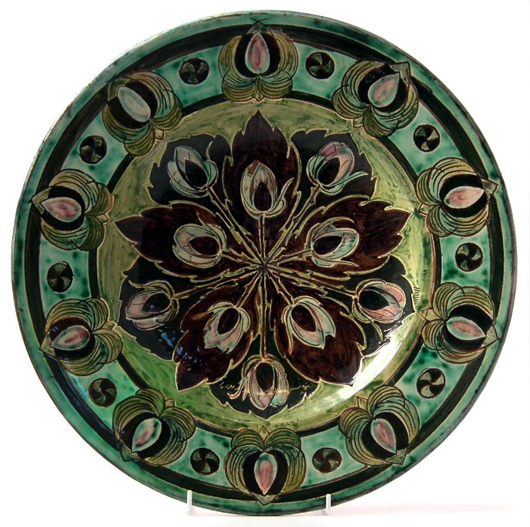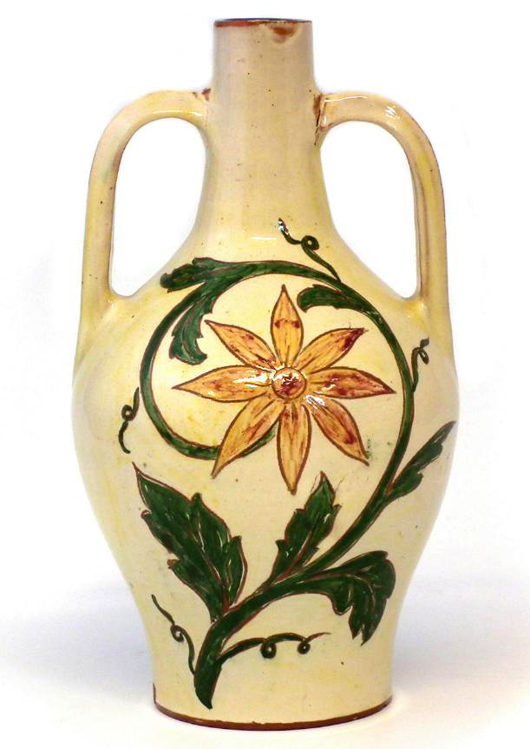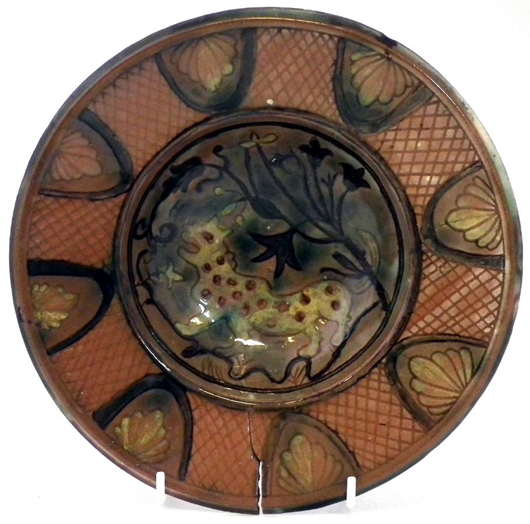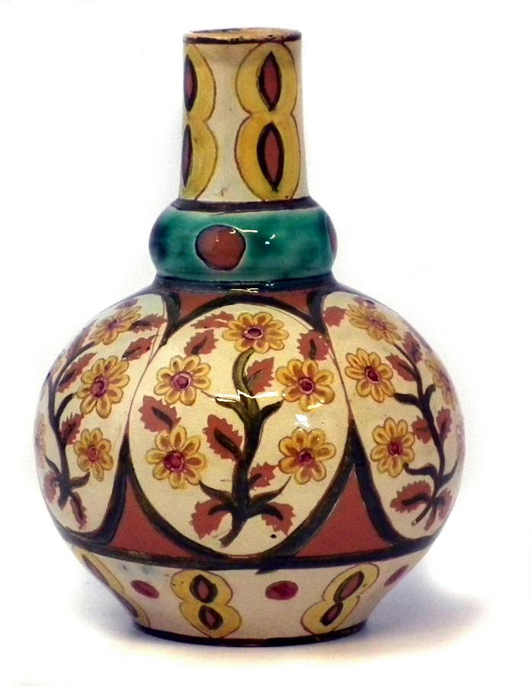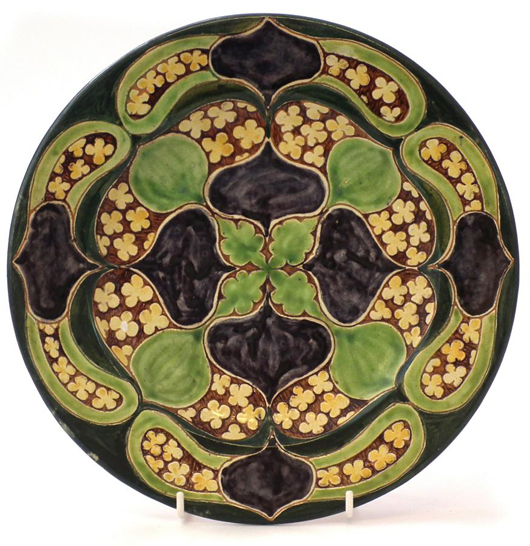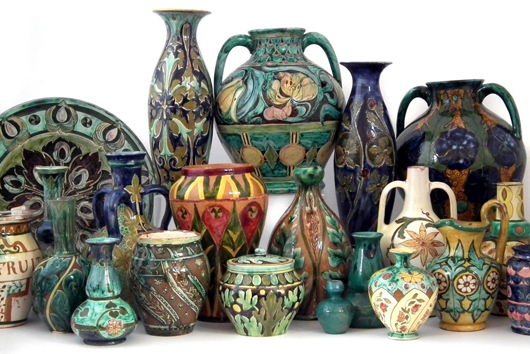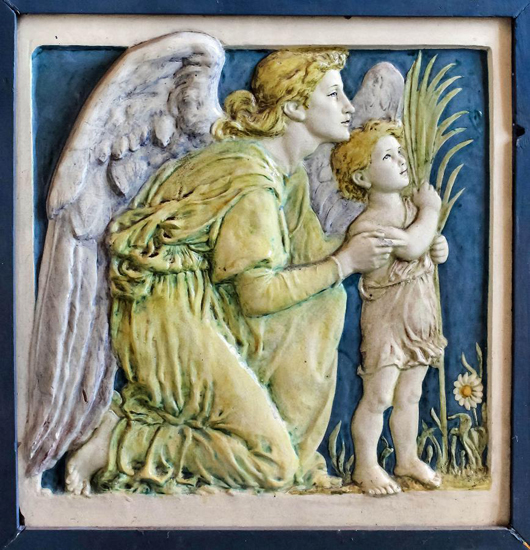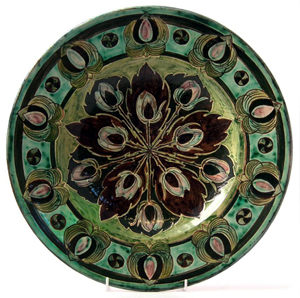
LONDON – Perhaps it’s sheer coincidence, but the current rise in the popularity of Della Robbia pottery – and hence the spiraling sums it’s fetching in the saleroom – can be attributed to the publication earlier this year of the definitive new book on the subject. Whether it will be sustained is another matter.
The Della Robbia Pottery, Birkenhead, 1894-1906, published by the Antique Collectors’ Club, is a scholarly work charting what must be one of the shortest-lived ceramics enterprises ever.
Its strength for me, however, is an A to Z list of the artists and workers employed there and the marks they used to identify their work. Many even have head and shoulder portrait photographs, making it surely the most complete list to date. It brings every identifiable piece to life, adding another dimension to the joy of collecting pieces from this unique factory.
Equally intriguing, of course, is the number of pieces and the workers responsible for making them yet to be identified, known either not at all or by only their Christian names or initials, both areas of collecting that could make further research highly rewarding.
The book’s author is Peter Hyland, a member of the Northern Ceramic and the English Ceramic Societies and a senior volunteer at the Wedgwood Museum in Stoke. He explains that at first, male workers handled the unfired clay, while the women were responsible for painting the fired ware.
Over time, however, this demarcation became blurred and pieces with just one set of initials or monogram indicate that one person was responsible for both designing and incising and painting its decoration. Perhaps because female artists tended to stay at the factory longer, partly because they had received some form of art training, surviving pieces by them appear to be more readily available to today’s collectors.
Royal Doulton had its Barlow sisters; Wedgwood its Daisy Makeig Jones; and the Staffordshire Potteries, such gifted individuals as Clarice Cliff, Charlotte Rhead and Susie Cooper. Della Robbia was not lacking in talented female artist designers, any or all of whose work would make a fascinating collection.
The pieces illustrated are part of a large collection coming up for sale at Nantwich, Cheshire, auctioneers Peter Wilson on Nov. 26-27. Thanks to Hyland, we have biographies of most of them.
Top of any list must be Cassandra Annie Walker, whom Hyland describes as the mainstay of the pottery. Not only did she work there almost continuously for the short time it was in production, she was arguably its best artist designer.
Walker was born into a relatively well off Liverpool family in 1875, joining Della Robbia not long after it started in 1894. Soon her name was being attached to pieces on exhibition, notably those at Liverpool’s Walker Art Gallery and at London’s Albert Hall, and as an assistant to Harold Rathbone, the pottery’s founder. She attended classes at Liverpool School of Architecture and Applied Arts (the Art Sheds) and won a scholarship to take a course at Westminster School of Art in London.
She specialized in wall plaques, decorated with colorful patterns of interweaving Art Nouveau plant and organic forms, combined with heraldic and Celtic motifs. Their designs achieve a harmony between the shape of the pots and the designs that are woven across their surfaces.
She emigrated to Canada two years after the factory closed and died in 1936. Look for her initials “CAW”, “CW” or her monogram of a W surrounded by a curly C. Look also for the stylized sailing ship logo that appears on much of the ware.
Annie Smith’s story is less than happy. She was born in Birkenhead in 1876 and was adopted by a railway watchman and his Welsh wife in 1881. By 1896, she was working as a colorist at the pottery, during which time she signed and dated some pieces, but what happened next is not known.
The 1901 census lists her as a patient in Chester’s lunatic asylum. Later that year she signed on at the Art Sheds for painting and drawing classes, resuming her work at the pottery until its closure. In 1911, she was unmarried and still living, with her adoptive parents. Her work is marked “AS”, while her monogram is formed by her intertwined initials traced by a continuous line.
Liz, or Lizzie, Wilkins was another young woman from Birkenhead who joined the pottery soon after it opened and left in 1904 to get married. Despite having had no art training, she incised designs on pottery prior to painting it and her painted initials are said to be commonly found. She was also one of the artists entrusted with painting the Della Robbia panels for the fountain in the Savoy Hotel.
Unlike all other Della Robbia designers, Suffolk artist and sculptor Ellen Mary Rope (1855-1934) was the only one who did not actually work at the pottery. Instead, she was persuaded by Rathbone to supply designs and plaster models which, The Magazine of Art stated in 1897, were “peculiarly adaptable to Della Robbia methods.”
In an auction earlier this month, a rare pair of 20-inch square Della Robbia panels, one with an angel and a child, the other with a mother and child, the child holding a lily sold for a thumping £8,500 ($13,700).
Both were designs done originally as the outer panels of a triptych in memory of the sculptor’s brother, Dr. Henry John Rope. The triptych was installed in the Royal Shrewsbury Hospital, while the pottery subsequently produced and sold a small number of the panels inscribed with her signature.

ADDITIONAL IMAGES OF NOTE
